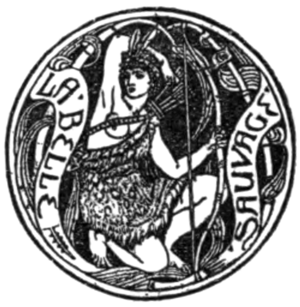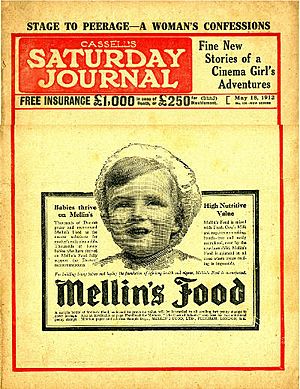Cassell (publisher) facts for kids
| Parent company | Octopus Publishing Group (Lagardère Publishing) |
|---|---|
| Founded | 1848 |
| Founder | John Cassell |
| Country of origin | United Kingdom |
| Headquarters location | Victoria Embankment London, EC4 United Kingdom |
| Publication types | books |
Cassell is a British company that publishes books. It was started in 1848 by John Cassell. By the 1890s, it had grown into a large international publishing group.
Over the years, Cassell changed hands several times. In 1995, it bought another publisher called Pinter Publishers. Then, in 1998, the Orion Publishing Group bought Cassell. Some parts of Cassell, like Cassell Reference and Cassell Military, later joined with other publishers to form a new division. Today, Cassell Illustrated is still a publishing name (called an "imprint") under the Octopus Publishing Group.
Contents
The Story of Cassell
How John Cassell Started
John Cassell (1817–1865) had many different jobs before he became a publisher. He was a carpenter, a preacher, and even sold tea and coffee! On July 1, 1848, he published his very first weekly newspaper. It was called The Standard of Freedom. This newspaper supported ideas like religious and political freedom. Another popular publication he created was The Working Man's Friend.
By 1849, John Cassell was busy with both his publishing and his grocery business. In 1851, his publishing work grew so much that he rented part of La Belle Sauvage. This was an old inn in London that had been a playhouse long ago. The old inn was later taken down in 1873 to make way for a railway. Cassell then built new offices nearby.
New Partners and Growth
John Cassell faced some financial difficulties in June 1855. Two partners from a printing company, Thomas Dixon Galpin and George William Petter, bought his publishing business and took on his debts. From 1855 to 1858, their printing company was known as Petter and Galpin.
In 1858, John Cassell became a junior partner in the company, which was then called Cassell, Petter & Galpin. Thomas Galpin was a very smart business manager. In 1878, a new partner named Robert Turner joined, and the company's name changed again to Cassell, Petter, Galpin & Company.
Becoming Cassell and Company, Ltd.
George Petter retired in 1883. After that, the company became Cassell and Company, Ltd. The company continued to grow well until 1888. At that time, Petter passed away, and Galpin retired from his managing role. Robert Turner then became the chairman.
By July 1887, Cassell & Company was advertising its books in London, Paris, New York, and Melbourne. This shows how big the company had become!
New Leaders and Changes
Sir Thomas Wemyss Reid was the general manager until 1905. Then, Arthur Spurgeon took over and helped the company become strong again. Cassell mainly published magazines, but Spurgeon focused on making the book publishing side even better.
In the early 1950s, Cassell's moved to new offices. They asked a sculptor named David McFall to create a statue of Princess Pocahontas. This statue was very important to them. Their old company symbol, a small statue by Eric Gill, had been destroyed during bombing raids in World War II. The new, larger-than-life statue of Pocahontas became a symbol of their fresh start. It stood proudly at the entrance of their main office.
Changing Hands Again
In 1969, an American company called Crowell Collier & Macmillan bought Cassell. This company later changed its name to Macmillan Inc.. Macmillan Inc. sold Cassell to CBS in 1982. Then, in 1986, a group of managers bought Cassell from CBS.
In October 1992, Cassell bought another publisher, Victor Gollancz Ltd. In June 1994, Cassell became a public company, meaning its shares could be bought and sold by anyone.
As Cassell's business changed, they eventually moved from their grand offices. They took the Pocahontas statue with them. It is believed that the statue was sold to a private collector in 1996.
In December 1998, the Orion Publishing Group took over Cassell. In October 1999, some of Cassell's academic and religious book lists joined with an American company called Continuum. They formed a new group called the Continuum International Publishing Group.
Past Book Series from Cassell
Cassell published many different series of books over the years. Here are some of them:
- Belle Sauvage Library (1963)
- Cassell's Blue Library (1891)
- Cassell's Miniature Library of the Poets
- Cassell’s National Library (1886–1914)
- Cassell’s Pocket Library (1895, 1928–1955)
- Cassell's Pocket Reference Library (1910)
- Cassell's Red Library (1884)
- Cassell’s Shilling Novels (1885–1934)
- First Novel Library (1966–1971)
- Helicon Poetry Series (1925)
- Little Classics (1909)
- Living Thoughts Library (1939–1950)
- People’s Library (1907–1933)
- Red Lion Lives
- Seafarers’ Library (1928–1929)
- The Unknown Library (around 1895)
Past Magazines from Cassell
Cassell also published many popular magazines and journals. Some of these include:
- Cassell's Magazine (1864–73)
- Cassell's household guide (1869)
- Cassell's Illustrated Travels (around 1872–73)
- Cassell's Family Magazine (1874–97)
- Cassell's Magazine (1897–1912)
- Cassell's Saturday Journal (1883–1921)
- Cassell's Weekly (1923), later T.P.'s & Cassell's Weekly (1923–1927)
- Chums (1892–1934)
- The Echo (1868–1905)
- The Lady's World (1886), later The Woman's World (1887–1890), edited by Oscar Wilde
- Little Folks (1871–1933), edited by Sam Hield Hamer (1895–1907)
- The Illustrated Magazine of Art (1853–54), later The Magazine of Art (1878–1904)
- The New Magazine (1909–1927)
- The New Penny Magazine (1898–1902), later The Penny Magazine (1903–1925), and Cassell's Popular Magazine (1925)
- The Quiver (1861–1956)
- The Story-Teller (1907–1937)
- Work (1889–1924)
More to Explore
- Gustave Doré's illustrations for La Grande Bible de Tours




